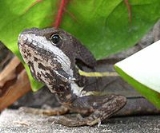
Corytophanidae
Encyclopedia
Corytophanidae is a family
of lizards also called casque head lizards or helmeted lizards. They typically have well-developed head crests in the shape of a casque
. This crest is a sexually dimorphic characteristic in males of Basiliscus, but is present in both sexes of Corytophanes and Laemanctus (Pough et al. 2003). In Corytophanes, these crests are used in defensive displays where the lateral aspect of the body is brought about to face a potential predator in an effort to look bigger (Pough et al. 2003). There are 9 known species of casque heads from 3 genera.
Casque heads are moderately sized forest-dwelling lizards with laterally compressed bodies. They are found from Mexico
, through Central America
, and as far south as Ecuador
. Unlike many of their close relatives, they are unable to break off their tails
when captured, probably because the tail is essential as a counterbalance during rapid movement. Despite the small size of the group, it includes both egg-laying species and some that give birth to live young.
Family (biology)
In biological classification, family is* a taxonomic rank. Other well-known ranks are life, domain, kingdom, phylum, class, order, genus, and species, with family fitting between order and genus. As for the other well-known ranks, there is the option of an immediately lower rank, indicated by the...
of lizards also called casque head lizards or helmeted lizards. They typically have well-developed head crests in the shape of a casque
Casque
Casque can refer to:* French word for helmet* An enlargement on the upper mandible of the bill of some species of birds, including many hornbills*Hornbill ivory: the casque of the Helmeted Hornbill, collected as a decorative material...
. This crest is a sexually dimorphic characteristic in males of Basiliscus, but is present in both sexes of Corytophanes and Laemanctus (Pough et al. 2003). In Corytophanes, these crests are used in defensive displays where the lateral aspect of the body is brought about to face a potential predator in an effort to look bigger (Pough et al. 2003). There are 9 known species of casque heads from 3 genera.
Casque heads are moderately sized forest-dwelling lizards with laterally compressed bodies. They are found from Mexico
Mexico
The United Mexican States , commonly known as Mexico , is a federal constitutional republic in North America. It is bordered on the north by the United States; on the south and west by the Pacific Ocean; on the southeast by Guatemala, Belize, and the Caribbean Sea; and on the east by the Gulf of...
, through Central America
Central America
Central America is the central geographic region of the Americas. It is the southernmost, isthmian portion of the North American continent, which connects with South America on the southeast. When considered part of the unified continental model, it is considered a subcontinent...
, and as far south as Ecuador
Ecuador
Ecuador , officially the Republic of Ecuador is a representative democratic republic in South America, bordered by Colombia on the north, Peru on the east and south, and by the Pacific Ocean to the west. It is one of only two countries in South America, along with Chile, that do not have a border...
. Unlike many of their close relatives, they are unable to break off their tails
Autotomy
Autotomy or self amputation is the act whereby an animal severs one or more of its own appendages, usually as a self-defense mechanism designed to elude a predator's grasp...
when captured, probably because the tail is essential as a counterbalance during rapid movement. Despite the small size of the group, it includes both egg-laying species and some that give birth to live young.
Genera and species
Family Corytophanidae- Genus Basiliscus
- common basiliskCommon BasiliskThe Common Basilisk is a lizard found in Central and South American rainforests near rivers and streams.The basilisk is part of the corytophanid family...
- Basiliscus basiliscus - Western or red-headed basiliskBasiliscus galeritusThe Western basilisk, or red-headed basilisk , is a large species of corytophanid lizard.-Geographic range:It inhabits western Colombia and Ecuador up through Central America.-Description:...
- Basiliscus galeritus - green or plumed basiliskPlumed basiliskThe plumed basilisk, Basiliscus plumifrons, also called a green basilisk, double crested basilisk, or Jesus Christ lizard, is a species of corytophanid to Latin America.-Taxonomy and etymology:...
- Basiliscus plumifrons - brown or striped basiliskBrown basiliskThe Brown Basilisk or Striped Basilisk is one species of basilisk lizard. They are native to Panama, Belize, northwestern Colombia and Costa Rica, but have been introduced into the U.S...
- Basiliscus vittatus
- common basilisk
- Genus CorytophanesCorytophanesCorytophanes is a genus of Neotropical lizards, commonly referred to as helmeted iguanas or helmeted basilisks. They are all arboreal, and reside in tropical forests...
- helmeted iguanaHelmeted IguanaThe helmeted iguana is a species of lizard found from southern Mexico to South America. It lives in rainforests. It has long limbs and climbs well. It feeds on insects, spiders, worms, and other lizards...
- Corytophanes cristatus - Hernandez's helmeted basilisk - Corytophanes hernandezi
- Guatemalan helmeted basiliskGuatemalan Helmeted BasiliskThe Guatemalan helmeted basilisk is a species of lizard in the family Corytophanidae that is found in Guatemala and southern Mexico....
- Corytophanes percarinatus
- helmeted iguana
- Genus LaemanctusLaemanctusLaemanctus is a genus of corytophanid lizards commonly referred to as conehead lizards or casquehead iguanas.The genus consists of two recognized species with six subspecies:*Eastern Casquehead Iguana, Laemanctus longipes...
- Eastern casquehead iguana - Laemanctus longipes
- serrated casquehead iguana - Laemanctus serratus

